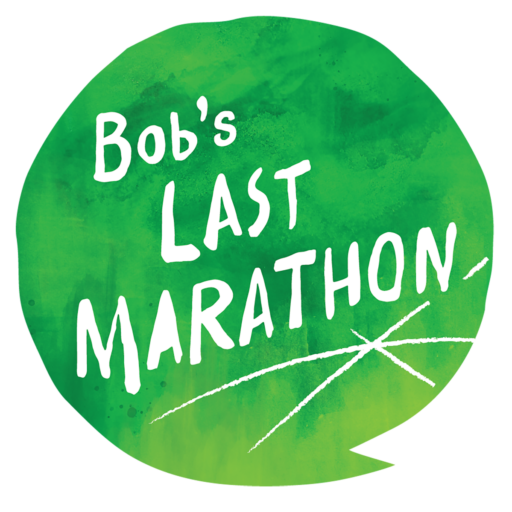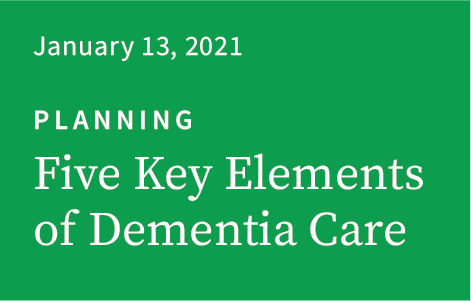Transcript
Five Key Elements of Dementia Care
It was the fall of 2013, a year after Bob was diagnosed; I’d just started coming to terms with his illness. We had gotten a few things into motion—a support group and connecting with the Alzheimer’s Association—and we were trying to figure out what lay ahead. A routine trip to visit my daughter led us to Dr. Arnold, at that time the director of the Penn Memory Center in Philadelphia.
What Dr. Arnold said to me that afternoon would inform every single decision I made for Bob, giving me the most valuable gift: a framework for caring for him. After listening to my barrage of questions, Dr. Arnold explained to me that there were five key elements of dementia care to keep in mind as I made choices to give Bob the best quality of life for the longest time possible. I don’t know if I wrote them down, but from that point on, not a day went by without my thinking about them.
As Dr. Arnold explained it, the five key elements to keep in mind are medication, diet, exercise, social activities, and cognitive therapy.
It seems so simple, but in a world that felt like it was crumbling beneath my feet, the five elements helped keep me grounded. Over time, I learned that they overlapped … managing one element often had a positive effect on others.
The mention of medication brought up something that I’ve learned in my years in health care communications, that following a drug regimen is critical; drugs don’t work unless they’re taken.
To ensure that happens, there usually comes a time when caregivers need to take over. In addition to two medications for Alzheimer’s, Bob was taking medications for other health problems. So it was especially important that I take ownership of his medications, make sure they were taken as instructed, and that refills were ordered in time so there were no disruptions. Fortunately, it was early enough in the course of his disease that we could discuss it. And Bob was an easygoing person, so he happily allowed me to take over—which was kind of the dynamic of our relationship anyway.
As runners, Bob and I were fairly conscious about what we ate. So we wondered whether a diagnosis of Alzheimer’s disease would call for a change in our diet. Dr. Arnold recommended the Mediterranean diet—which is well known for its heart-healthy benefits, but there’s also some evidence it can help stave off Alzheimer’s-related changes to the brain.
Bob and I were already big fans of fish and vegetables, so it wasn’t a big leap to cook with fruits, vegetables, whole grains, and lean protein—the staples of the Mediterranean diet. One of our biggest challenges was cutting down on carbohydrates—pasta, bread, potatoes. So, yes, we cheated a little here and there. Life with Alzheimer’s is tough enough without the occasional guilty pleasure, which for Bob was bread and cereal, and for me, ice cream.
Dr. Arnold didn’t need to preach the benefits of exercise to Bob and me. Since we were runners, it was central to our routine. But when I learned it was important to the health of a person with dementia, I realized that I would need to consciously continue to make exercise a part of Bob’s routines.
In Bob’s case, vascular dementia contributed to a loss of coordination and fluidity in his movements … eventually his gait became awkward, and I could see in his eyes that walking took some determination. But we discovered different ways to make exercise work. We introduced a walker—I remember him stepping away from his walker momentarily to shoot hoops. To maintain muscle tone, Bob lifted weights and continued doing push-ups—but modified to do while standing up.
I also found that very often, exercise means interacting with other people—walking, dancing in a group, working out in a group—rather than isolation.
The day before he passed away, Bob was doing hand weights in his wheelchair—by that time he was no longer able to walk on his own. I found it comforting to feel his strong grip, and to see the inevitable smile, when he was up and about, exercising at the level that he could.
Next on the list of five key elements was social interaction, which benefits Alzheimer’s patients by keeping the mind active. I remember other caregivers in support groups talking about needing to keep their loved ones at home full time for the best care. What they didn’t realize was that they were depriving their loved one of social interactions—to say nothing of depriving themselves of a break, which is so important but often overlooked.
Knowing the importance of social interaction, both personally and for his disease, helped me make the decision to enroll Bob in a day care program, even when he was still largely independent. Sure enough, Bob became one of the best-liked members of his day care program. At first, he would hang around the coffeepot and chat. Later, I would find him clapping enthusiastically when someone told a story. Or, later still, he might wake up from his “snooze” as he called it when people started music or games.
The fifth key element, cognitive therapy, or cognitive training, was actually one issue on my mind before we saw Dr. Arnold. I first heard about it through the Alzheimer’s Association and was considering in-home programs offered by a group in our neighborhood. We opted for in-home cognitive therapy, but as I learned, many adult day care programs include some form of cognitive therapy.
Not to be confused with cognitive behavioral therapy, a type of psychotherapy, cognitive therapy focuses on improving cognitive skills—such as thinking, concentration, language, and memory. It’s a kind of exercise therapy for the brain.
Twice a week, in 75-minute sessions, a trained cognitive interventionist would engage Bob in conversation, encourage him to tell stories, work on puzzles, solve math problems, and play games on an iPad. Often, as a warm-up, the interventionist would go for a walk with Bob. His monthly progress was tracked by his ability to engage and focus, as well as overall cognitive skills.
As Bob’s Alzheimer’s progressed, and solving math and picture puzzles became too difficult, therapy shifted toward art and music. Even the week before he passed away, when Bob was physically too weak to go to day care, he completed a painting with the supervision of his art therapist—a piece of art that graces the entry hall of my home now.
Medication. Diet. Exercise. Social interaction. Cognitive therapy. These five key elements were central to all my decisions for Bob’s care. I used them as a checklist when I began to put together a care team, evaluate day care programs, interview home care staff, and decide between home care and long-term care facilities. Day to day, I used the five key elements as mental touchpoints as I planned out Bob’s day, his meals, and his activities. Even today, as I look up from my desk, I have vivid memories of Bob walking with Miriam, one of two favorite regular caregivers, singing “You Are My Sunshine” as he started his day.
Lena Chow Kuhar

